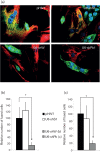Silencing of endogenous envelope genes in human choriocarcinoma cells shows that envPb1 is involved in heterotypic cell fusions
- PMID: 22573740
- PMCID: PMC3541762
- DOI: 10.1099/vir.0.041764-0
Silencing of endogenous envelope genes in human choriocarcinoma cells shows that envPb1 is involved in heterotypic cell fusions
Abstract
Syncytin-1 and envPb1 are two conserved envelope genes in the human genome encoded by single loci from the HERV-W and -Pb families, respectively. To characterize the role of these envelope proteins in cell-cell fusion, we have developed lentiviral vectors that express short hairpin RNAs for stable knockdown of syncytin-1 and envPb1. Analysis of heterotypic fusion activity between trophoblast-derived choriocarcinoma BeWo cells, in which syncytin-1 and envPb1 are specifically silenced, and endothelial cells demonstrated that both syncytin-1 and envPb1 are important to fusion. The ability to fuse cells makes syncytin-1 and envPb1 attractive candidate molecules in therapy against cancer. Our available vectors may help eventually to decipher roles for these genes in human health and/or disease.
Figures

Similar articles
-
Human endogenous retrovirus-W envelope (syncytin) is expressed in both villous and extravillous trophoblast populations.J Gen Virol. 2006 Jul;87(Pt 7):2067-2071. doi: 10.1099/vir.0.81412-0. J Gen Virol. 2006. PMID: 16760410
-
Reduced syncytin-1 expression in choriocarcinoma BeWo cells activates the calpain1-AIF-mediated apoptosis, implication for preeclampsia.Cell Mol Life Sci. 2014 Aug;71(16):3151-64. doi: 10.1007/s00018-013-1533-8. Epub 2014 Jan 12. Cell Mol Life Sci. 2014. PMID: 24413738 Free PMC article.
-
Proliferation and cell-cell fusion of endometrial carcinoma are induced by the human endogenous retroviral Syncytin-1 and regulated by TGF-beta.J Mol Med (Berl). 2007 Jan;85(1):23-38. doi: 10.1007/s00109-006-0104-y. Epub 2006 Oct 26. J Mol Med (Berl). 2007. PMID: 17066266
-
Epigenetic and non-epigenetic regulation of syncytin-1 expression in human placenta and cancer tissues.Cell Signal. 2014 Mar;26(3):648-56. doi: 10.1016/j.cellsig.2013.11.002. Epub 2013 Nov 9. Cell Signal. 2014. PMID: 24216608 Review.
-
Endogenous retroviral syncytin: compilation of experimental research on syncytin and its possible role in normal and disturbed human placentogenesis.Mol Hum Reprod. 2004 Aug;10(8):581-8. doi: 10.1093/molehr/gah070. Epub 2004 Jun 4. Mol Hum Reprod. 2004. PMID: 15181178 Review.
Cited by
-
Human endogenous retroviruses in cancer: Expression, regulation and function.Oncol Lett. 2021 Feb;21(2):121. doi: 10.3892/ol.2020.12382. Epub 2020 Dec 17. Oncol Lett. 2021. PMID: 33552242 Free PMC article. Review.
-
Human endogenous retrovirus regulates the initiation and progression of cancers (Review).Mol Clin Oncol. 2022 Aug 3;17(4):143. doi: 10.3892/mco.2022.2576. eCollection 2022 Oct. Mol Clin Oncol. 2022. PMID: 36157315 Free PMC article. Review.
-
Galectin-1 Modulates the Fusogenic Activity of Placental Endogenous Retroviral Envelopes.Viruses. 2023 Dec 16;15(12):2441. doi: 10.3390/v15122441. Viruses. 2023. PMID: 38140682 Free PMC article.
-
Evolution and antiviral activity of a human protein of retroviral origin.Science. 2022 Oct 28;378(6618):422-428. doi: 10.1126/science.abq7871. Epub 2022 Oct 27. Science. 2022. PMID: 36302021 Free PMC article.
-
VEGFA-targeting miR-agshRNAs combine efficacy with specificity and safety for retinal gene therapy.Mol Ther Nucleic Acids. 2022 Feb 28;28:58-76. doi: 10.1016/j.omtn.2022.02.019. eCollection 2022 Jun 14. Mol Ther Nucleic Acids. 2022. PMID: 35356684 Free PMC article.
References
-
- Antony J. M., van Marle G., Opii W., Butterfield D. A., Mallet F., Yong V. W., Wallace J. L., Deacon R. M., Warren K., Power C. (2004). Human endogenous retrovirus glycoprotein-mediated induction of redox reactants causes oligodendrocyte death and demyelination. Nat Neurosci 7, 1088–1095 10.1038/nn1319 - DOI - PubMed
-
- Bjerregaard B., Talts J. F., Larsson L. I. (2011). The endogenous envelope protein syncytin is involved in myoblast fusion. In Cell Fusions: Regulation and Control, pp. 267–275 Edited by Larsson L. I. New York: Springer; 10.1007/978-90-481-9772-9_13 - DOI
Publication types
MeSH terms
Substances
Grants and funding
LinkOut - more resources
Full Text Sources
Miscellaneous

